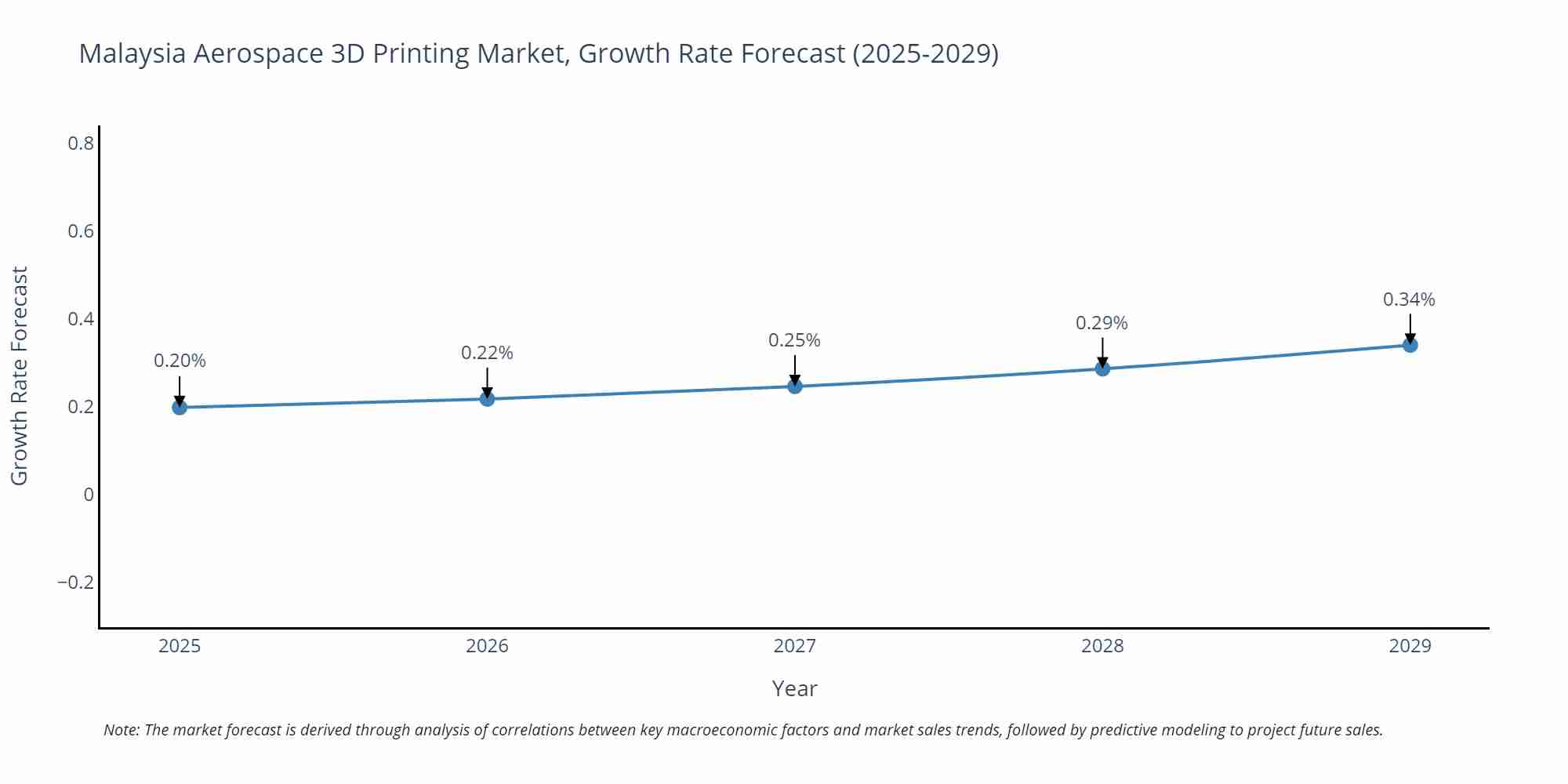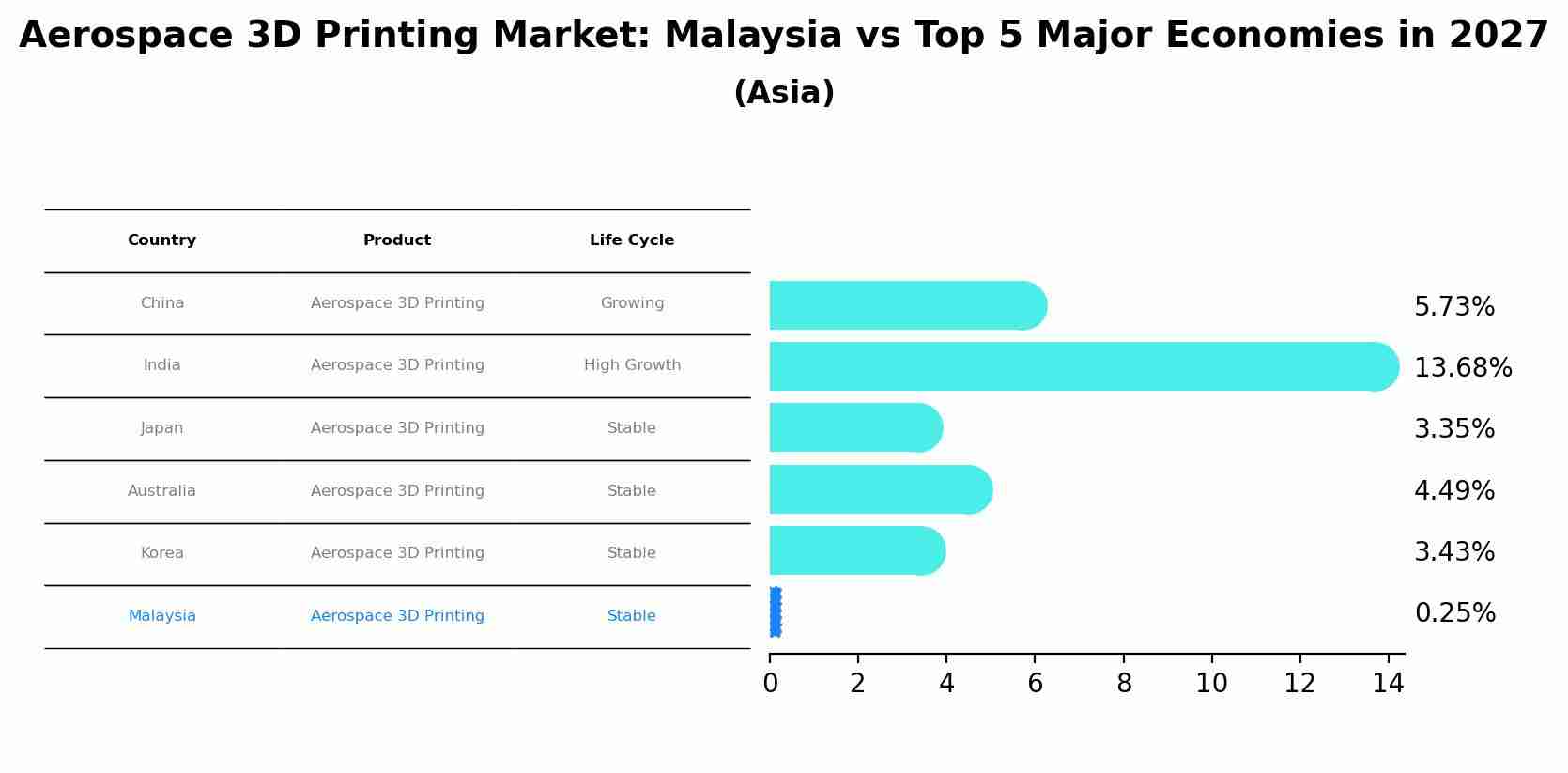Malaysia Aerospace 3D Printing Market (2025-2031) Outlook | Growth, Value, Trends, Revenue, Forecast, Companies, Industry, Share, Size & Analysis
| Product Code: ETC4552167 | Publication Date: Jul 2023 | Updated Date: Aug 2025 | Product Type: Report | |
| Publisher: 6Wresearch | Author: Ravi Bhandari | No. of Pages: 85 | No. of Figures: 45 | No. of Tables: 25 |
Malaysia Aerospace 3D Printing Market Size Growth Rate
The Malaysia Aerospace 3D Printing Market is poised for steady growth rate improvements from 2025 to 2029. The growth rate starts at 0.20% in 2025 and reaches 0.34% by 2029.

Aerospace 3D Printing Market: Malaysia vs Top 5 Major Economies in 2027 (Asia)
By 2027, Malaysia's Aerospace 3D Printing market is forecasted to achieve a stable growth rate of 0.25%, with China leading the Asia region, followed by India, Japan, Australia and South Korea.

malaysia aerospace 3d printing market overview
3D printing technology is making inroads into the aerospace industry, including Malaysia. The aerospace 3D printing market in Malaysia is gaining traction as it allows for the rapid prototyping and production of complex aerospace components. Additive manufacturing offers advantages in terms of reduced material waste and increased design flexibility. With a focus on lightweight and advanced materials, the aerospace 3D printing market is anticipated to witness growth as manufacturers and aerospace companies explore new applications for this technology.
Drivers of the Market
The Malaysia Aerospace 3D Printing Market is being propelled by the transformative potential of additive manufacturing technologies in the aviation industry. 3D printing offers unprecedented design freedom, reduced material waste, and shortened production cycles. These advantages are particularly crucial in aerospace, where lightweight and complex components are paramount. The continuous development of high-performance materials suitable for aerospace applications further bolsters the adoption of 3D printing technologies. As the industry increasingly recognizes the cost and performance benefits of additive manufacturing, the market for aerospace 3D printing in Malaysia is set for substantial growth.
Challenges of the Market
Challenges in the Aerospace 3D Printing market in Malaysia include the need for certification and quality control of 3D-printed aerospace components. Ensuring that printed parts meet safety and reliability standards is essential. Material development and cost-effectiveness are also concerns, as aerospace-grade materials can be expensive.
Covid-19 Impact of the Market
The aerospace 3D printing market in Malaysia faced challenges during the COVID-19 pandemic. Supply chain disruptions, coupled with a temporary reduction in demand for aerospace components, led to a slowdown in the adoption of 3D printing technologies. Many companies deferred their investments in additive manufacturing processes as they navigated through uncertainties. However, as the industry stabilizes, there is a renewed emphasis on leveraging 3D printing to achieve cost efficiencies, reduce lead times, and enable complex geometries in aerospace manufacturing.
Leading Players of the Market
3D printing is revolutionizing aerospace parts production. Leading Players include Stratasys, EOS, and General Electric (GE) Additive.
Key Highlights of the Report:
- Malaysia Aerospace 3D Printing Market Outlook
- Market Size of Malaysia Aerospace 3D Printing Market, 2024
- Forecast of Malaysia Aerospace 3D Printing Market, 2031
- Historical Data and Forecast of Malaysia Aerospace 3D Printing Revenues & Volume for the Period 2021-2031
- Malaysia Aerospace 3D Printing Market Trend Evolution
- Malaysia Aerospace 3D Printing Market Drivers and Challenges
- Malaysia Aerospace 3D Printing Price Trends
- Malaysia Aerospace 3D Printing Porter's Five Forces
- Malaysia Aerospace 3D Printing Industry Life Cycle
- Historical Data and Forecast of Malaysia Aerospace 3D Printing Market Revenues & Volume By Offerings for the Period 2021-2031
- Historical Data and Forecast of Malaysia Aerospace 3D Printing Market Revenues & Volume By Printers for the Period 2021-2031
- Historical Data and Forecast of Malaysia Aerospace 3D Printing Market Revenues & Volume By Materials for the Period 2021-2031
- Historical Data and Forecast of Malaysia Aerospace 3D Printing Market Revenues & Volume By Services for the Period 2021-2031
- Historical Data and Forecast of Malaysia Aerospace 3D Printing Market Revenues & Volume By Software for the Period 2021-2031
- Historical Data and Forecast of Malaysia Aerospace 3D Printing Market Revenues & Volume By Platform for the Period 2021-2031
- Historical Data and Forecast of Malaysia Aerospace 3D Printing Market Revenues & Volume By Aircraft for the Period 2021-2031
- Historical Data and Forecast of Malaysia Aerospace 3D Printing Market Revenues & Volume By UAVs for the Period 2021-2031
- Historical Data and Forecast of Malaysia Aerospace 3D Printing Market Revenues & Volume By Spacecraft for the Period 2021-2031
- Historical Data and Forecast of Malaysia Aerospace 3D Printing Market Revenues & Volume By Application for the Period 2021-2031
- Historical Data and Forecast of Malaysia Aerospace 3D Printing Market Revenues & Volume By Prototyping for the Period 2021-2031
- Historical Data and Forecast of Malaysia Aerospace 3D Printing Market Revenues & Volume By Tooling for the Period 2021-2031
- Historical Data and Forecast of Malaysia Aerospace 3D Printing Market Revenues & Volume By Functional Parts for the Period 2021-2031
- Malaysia Aerospace 3D Printing Import Export Trade Statistics
- Market Opportunity Assessment By Offerings
- Market Opportunity Assessment By Platform
- Market Opportunity Assessment By Application
- Malaysia Aerospace 3D Printing Top Companies Market Share
- Malaysia Aerospace 3D Printing Competitive Benchmarking By Technical and Operational Parameters
- Malaysia Aerospace 3D Printing Company Profiles
- Malaysia Aerospace 3D Printing Key Strategic Recommendations
Frequently Asked Questions About the Market Study (FAQs):
1 Executive Summary |
2 Introduction |
2.1 Key Highlights of the Report |
2.2 Report Description |
2.3 Market Scope & Segmentation |
2.4 Research Methodology |
2.5 Assumptions |
3 Malaysia Aerospace 3D Printing Market Overview |
3.1 Malaysia Country Macro Economic Indicators |
3.2 Malaysia Aerospace 3D Printing Market Revenues & Volume, 2021 & 2031F |
3.3 Malaysia Aerospace 3D Printing Market - Industry Life Cycle |
3.4 Malaysia Aerospace 3D Printing Market - Porter's Five Forces |
3.5 Malaysia Aerospace 3D Printing Market Revenues & Volume Share, By Offerings, 2021 & 2031F |
3.6 Malaysia Aerospace 3D Printing Market Revenues & Volume Share, By Platform, 2021 & 2031F |
3.7 Malaysia Aerospace 3D Printing Market Revenues & Volume Share, By Application, 2021 & 2031F |
4 Malaysia Aerospace 3D Printing Market Dynamics |
4.1 Impact Analysis |
4.2 Market Drivers |
4.2.1 Technological advancements in aerospace 3D printing technology |
4.2.2 Increasing demand for lightweight and complex aerospace components |
4.2.3 Growing investments in research and development in the aerospace industry |
4.3 Market Restraints |
4.3.1 High initial setup costs and ongoing maintenance expenses |
4.3.2 Regulatory challenges and compliance requirements in the aerospace sector |
5 Malaysia Aerospace 3D Printing Market Trends |
6 Malaysia Aerospace 3D Printing Market, By Types |
6.1 Malaysia Aerospace 3D Printing Market, By Offerings |
6.1.1 Overview and Analysis |
6.1.2 Malaysia Aerospace 3D Printing Market Revenues & Volume, By Offerings, 2021-2031F |
6.1.3 Malaysia Aerospace 3D Printing Market Revenues & Volume, By Printers, 2021-2031F |
6.1.4 Malaysia Aerospace 3D Printing Market Revenues & Volume, By Materials, 2021-2031F |
6.1.5 Malaysia Aerospace 3D Printing Market Revenues & Volume, By Services, 2021-2031F |
6.1.6 Malaysia Aerospace 3D Printing Market Revenues & Volume, By Software, 2021-2031F |
6.2 Malaysia Aerospace 3D Printing Market, By Platform |
6.2.1 Overview and Analysis |
6.2.2 Malaysia Aerospace 3D Printing Market Revenues & Volume, By Aircraft, 2021-2031F |
6.2.3 Malaysia Aerospace 3D Printing Market Revenues & Volume, By UAVs, 2021-2031F |
6.2.4 Malaysia Aerospace 3D Printing Market Revenues & Volume, By Spacecraft, 2021-2031F |
6.3 Malaysia Aerospace 3D Printing Market, By Application |
6.3.1 Overview and Analysis |
6.3.2 Malaysia Aerospace 3D Printing Market Revenues & Volume, By Prototyping, 2021-2031F |
6.3.3 Malaysia Aerospace 3D Printing Market Revenues & Volume, By Tooling, 2021-2031F |
6.3.4 Malaysia Aerospace 3D Printing Market Revenues & Volume, By Functional Parts, 2021-2031F |
7 Malaysia Aerospace 3D Printing Market Import-Export Trade Statistics |
7.1 Malaysia Aerospace 3D Printing Market Export to Major Countries |
7.2 Malaysia Aerospace 3D Printing Market Imports from Major Countries |
8 Malaysia Aerospace 3D Printing Market Key Performance Indicators |
8.1 Adoption rate of aerospace 3D printing technology in Malaysia |
8.2 Rate of innovation in aerospace 3D printing materials and processes |
8.3 Number of partnerships and collaborations between aerospace companies and 3D printing technology providers |
9 Malaysia Aerospace 3D Printing Market - Opportunity Assessment |
9.1 Malaysia Aerospace 3D Printing Market Opportunity Assessment, By Offerings, 2021 & 2031F |
9.2 Malaysia Aerospace 3D Printing Market Opportunity Assessment, By Platform, 2021 & 2031F |
9.3 Malaysia Aerospace 3D Printing Market Opportunity Assessment, By Application, 2021 & 2031F |
10 Malaysia Aerospace 3D Printing Market - Competitive Landscape |
10.1 Malaysia Aerospace 3D Printing Market Revenue Share, By Companies, 2024 |
10.2 Malaysia Aerospace 3D Printing Market Competitive Benchmarking, By Operating and Technical Parameters |
11 Company Profiles |
12 Recommendations |
13 Disclaimer |
- Single User License$ 1,995
- Department License$ 2,400
- Site License$ 3,120
- Global License$ 3,795
Search
Thought Leadership and Analyst Meet
Our Clients
Related Reports
- Germany Breakfast Food Market (2026-2032) | Industry, Share, Growth, Size, Companies, Value, Analysis, Revenue, Trends, Forecast & Outlook
- Australia Briquette Market (2025-2031) | Growth, Size, Revenue, Forecast, Analysis, Trends, Value, Share, Industry & Companies
- Vietnam System Integrator Market (2025-2031) | Size, Companies, Analysis, Industry, Value, Forecast, Growth, Trends, Revenue & Share
- ASEAN and Thailand Brain Health Supplements Market (2025-2031) | Strategy, Consumer Insights, Analysis, Investment Trends, Opportunities, Growth, Size, Share, Industry, Revenue, Segments, Value, Segmentation, Supply, Forecast, Restraints, Outlook, Competition, Drivers, Trends, Demand, Pricing Analysis, Competitive, Strategic Insights, Companies, Challenges
- ASEAN Bearings Market (2025-2031) | Strategy, Consumer Insights, Analysis, Investment Trends, Opportunities, Growth, Size, Share, Industry, Revenue, Segments, Value, Segmentation, Supply, Forecast, Restraints, Outlook, Competition, Drivers, Trends, Demand, Pricing Analysis, Competitive, Strategic Insights, Companies, Challenges
- Europe Flooring Market (2025-2031) | Outlook, Share, Industry, Trends, Forecast, Companies, Revenue, Size, Analysis, Growth & Value
- Saudi Arabia Manlift Market (2025-2031) | Outlook, Size, Growth, Trends, Companies, Industry, Revenue, Value, Share, Forecast & Analysis
- Uganda Excavator, Crane, and Wheel Loaders Market (2025-2031) | Strategy, Consumer Insights, Analysis, Investment Trends, Opportunities, Growth, Size, Share, Industry, Revenue, Segments, Value, Segmentation, Supply, Forecast, Restraints, Outlook, Competition, Drivers, Trends, Demand, Pricing Analysis, Competitive, Strategic Insights, Companies, Challenges
- Rwanda Excavator, Crane, and Wheel Loaders Market (2025-2031) | Strategy, Consumer Insights, Analysis, Investment Trends, Opportunities, Growth, Size, Share, Industry, Revenue, Segments, Value, Segmentation, Supply, Forecast, Restraints, Outlook, Competition, Drivers, Trends, Demand, Pricing Analysis, Competitive, Strategic Insights, Companies, Challenges
- Kenya Excavator, Crane, and Wheel Loaders Market (2025-2031) | Strategy, Consumer Insights, Analysis, Investment Trends, Opportunities, Growth, Size, Share, Industry, Revenue, Segments, Value, Segmentation, Supply, Forecast, Restraints, Outlook, Competition, Drivers, Trends, Demand, Pricing Analysis, Competitive, Strategic Insights, Companies, Challenges
Industry Events and Analyst Meet
Whitepaper
- Middle East & Africa Commercial Security Market Click here to view more.
- Middle East & Africa Fire Safety Systems & Equipment Market Click here to view more.
- GCC Drone Market Click here to view more.
- Middle East Lighting Fixture Market Click here to view more.
- GCC Physical & Perimeter Security Market Click here to view more.
6WResearch In News
- Doha a strategic location for EV manufacturing hub: IPA Qatar
- Demand for luxury TVs surging in the GCC, says Samsung
- Empowering Growth: The Thriving Journey of Bangladesh’s Cable Industry
- Demand for luxury TVs surging in the GCC, says Samsung
- Video call with a traditional healer? Once unthinkable, it’s now common in South Africa
- Intelligent Buildings To Smooth GCC’s Path To Net Zero


















